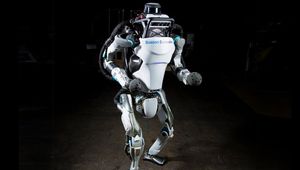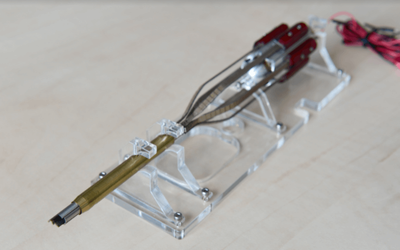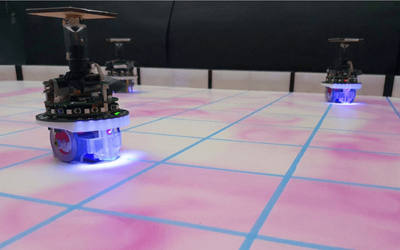Open-Source Decoder for Educational Escape Rooms
An open-source, reprogrammable 3D printed decoder for educational escape rooms.
Technical Specifications
| Total weight | 250g |
| Microcontroller | Arduino Nano USB |
| OS | Mac, Windows, and Linux |
| Display | 8x2 LCD Screen |
| average power required: 210mW | |
| Enclosure | 3D Printed by Ultimaker 3 printer |
| Material: PLA | |
| Time: 9 hours per pair | |
| Layer height: 0.2mm | |
| Fascia | Laser cut acrylic or 3D printed |
| Total System Lifetime | Over 20 hours |
| Minimum power requirement | 1.05Wh |
| Batteries | 3xAAA = 4.5Wh |
Overview
This tech spec was submitted by Robert Ross as part of the University Technology Exposure Program.
Problem / Solution
These days, people who enjoy taking part in leisure activities that include solving several puzzles within a set amount of time and experiencing the life of a detective for a while are drawn to escape rooms. The popularity of escape rooms as a social and enjoyable game has inspired more individuals to use them in the classroom as a way to teach students difficult concepts. The mechanics of an escape room include puzzles that must be solved to discover the key and unlock the lock. A lock, timeframe, and puzzles are thus a bare minimum requirement for an escape room to begin. Purchasing a sizable number of individually customizable combination padlocks and keeping timers for each player or team of players is necessary to establish an instructional escape room. Although using a gadget that enables the instructional designer to customize the number of locks and built-in timer should improve management logistics and coordination, this manual overhead is thought to not scale well with larger groups. The puzzles that can be played with the device only have numerical answers.
An open-source, reprogrammable numeric keypad-based lock (decoder) is designed with an integrated timer. Anyone willing to manufacture the design has access to the whole design, bill of materials, and assembly instructions for only 30.00 AUD. The design provides a platform that enables teachers to use escape rooms to creatively and amusingly impart their information. The design includes an LCD panel for visual feedback and several tunes for audio feedback that indicate whether the player succeeded or failed. The design can allow the player to enter numerical answers to stem-based questions using the numerical keys.
Design
The design is versatile, enabling someone with a broader understanding of electronics and assembly skills to use a variety of components or to introduce new electronic components. Aside from the decoder enclosure, keypad bracket (3-D printed with PLA), fascia (laser cut acrylic or 3-D printed), and PCB, the design also uses pre-made components. Additionally, it took 9 hours per pair to print the enclosures and brackets included in the design using an Ultimaker 3 printer with a 0.2mm layer height.
Using an open-source Arduino nano USB microcontroller, which is popular in embedded systems and robotics, to control the decoder. Although it might seem difficult to execute, this platform's convenient hardware and software enable students to begin building one even if they have no familiarity with electronics or programming. Additionally, it is compatible with a variety of computer platforms, including Mac, Windows, and Linux PCs, and it comes with a user interface that can be installed on one of the computers and used to set up and modify the decoder application.
Considering the decoder's power design, the paper made computations for the battery needs based on the performance capacity requirements. The minimum power demand of 1.05Wh was obtained by adding up the average power needed by the microprocessor and LCD screen (210 Mw) and multiplying that figure by the whole system lifetime of 5 hours. Hence, 3xAAA batteries are required because they supply approximately 3.6Wh more than the system needs to run for 20 hours.
Features and Capabilities
The decoder design is lightweight and useful for educational purposes since it weighs 250g. Once the decoder is linked to the computer, the software may be quickly set up and reconfigured by creating and loading an Arduino sketch.
The microcontroller is made up of a range of STEM-based problems, including those involving number base conversions, the use of multimeters, digital logic propagation, calculations using biological reagents, arithmetic, decoding waveforms, and programming.
The decoder is equipped with an Arduino that will compare the numerical key entered by the player with the correct answer when it has completed its analysis and conversion. When the time limit has been met, the Arduino will display the message "Game Over" on the LCD screen.
The decoder can also set time penalties for wrong answers and change its settings such that penalties don't apply at all or even increase by one-minute increments.
The team will be incorporating a feature that will connect WIFI to the boards. This feature will make it easier for escape room creators to set time limitations for larger groups and will directly assist teachers in identifying outliers in student performance.
References
A research paper describing the challenge, design, and outcome of the research.








